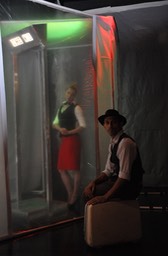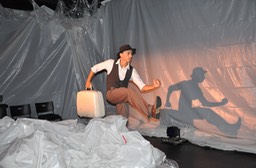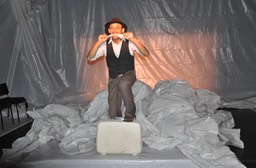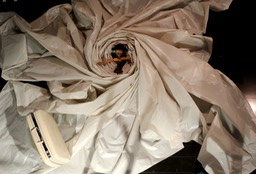MTC's Brookdale, a Surreal Dance of Mental and Physical Imprisonment
Imagine it’s February 7, 2013, and you’re leaving Miami after a monthlong visit with family and friends and resuming your dance career in Israel. At the airport, TSA agents repeatedly search and interrogate you, causing you to miss your connection. Why? Maybe it’s because of your Cuban passport and the many visas that mark your touring schedule. No one tells you.
These were the circumstances that began the cascade of frightening misadventures that inspired dancer/choreographer Lazaro Godoy’s solo dance performance, BrookDale, which premiered at Miami Theater Center’s SandBox stage June 10 and plays Fridays and Saturdays through June 25.
A graduate of Miami’s New World School of the Arts and Juilliard, Godoy has resided in Europe and Israel, but two years ago, he and partner Carlotta Praderacoproduced and performed the raw and provocative Bare Bones, also at the SandBox. More recent local presentations include Harmonicum Accordion for Miami Light Project and Medaka, a Tigertail commissioned dance.
Godoy’s harsh treatment at Miami International Airport provoked a physical and mental breakdown that sent him to Brookdale Hospital’s emergency room upon his connecting flight’s eventual arrival in New York. Disoriented and reacting badly to an IV, he yanked it from his rapidly swelling arm. “They relocated me to the psychiatric ward because they believed I was a danger to myself or others,” Godoy wrote in an introduction to his work. “They put me insmall room with only a mattress on the floor. From there, they administered a tranquilizer without my permission, closed me in a small room without a toilet, and left me alone.”
Godoy’s ordeal provides the core narrative ofBrookDale, and he immediately plunges audiences into the drama. Opening the storefront theater’s door, a “flight attendant” directs us into a narrow hallway, where a “TSA agent” demands that we place our personal items into plastic bags and pass through a “scanner.” We proceed into a square, dimly lit space draped with plastic sheeting and filled with penetrating engine noises and other oppressive sound effects. There, we wait as spectators are slowly led to their seats by the robotic, flashlight-wielding “hostess,” who sometimes separates couples. Nervous energy pervades, and the slender figure of the “traveler” finally enters the stark space; he holds a suitcase and evokes Charlie Chaplin’s beleaguered Little Tramp. Assailed by unseen forces, he nervously runs and waits and runs. By implication, he invokes the fear and oppression endured by citizens of Cuba and many other parts of the world.
To create the piece, Godoy needed sufficient separation and healing “to be able to express what my body has as a message from these experiences.” Only then “I could laugh about it and really celebrate life and what it is to be free,” he said. “It’s still surreal to me.”
That surreal quality is effectively translated in both the dancer’s tangles with his own body and the ubiquitous plastic sheeting that entwines and nearly smothers him.
In the second half of the performance, the protagonist “loses his suitcase and finds himself in another place that is completely restricted, and there's no freedom whatsoever," Godoy summarized. He somehow extracts a diminutive puppet from his suitcase, which serves as a tender “mini-me” companion in a sensuous Latin dance duet.
During a subsequent grueling, sweaty, anguished interlude, Godoy occupies a platform that serves as both his hospital bed and isolation chamber. He writhesand leaps amid the twisted sheets. A punishing struggle ensues, and hazmat-suit-clad orderlies strip and cruelly confine their captive.
Godoy originally reacted to his detention by entering dreamlike states and sound memories “that connected me to something real.” Later he collaborated with fellow Cuban artist Eligio Omni to produce a video, which conveys his virtual escape through family portraits and alluring landscapes of Israel and Cuba, projected on the wall. “It was sort of what held me together — those memories and visuals,” Godoy said.
“The best therapy for posttraumatic stress is dance movement and sound,” he continued. “My body can heal by constantly visiting those places and thoughts and working with them and feel them and not to be afraid and allow them to enter me and come out.”
The artist’s focus is not political, “but I cannot avoid it,” he remarked, “because we are all politics — our bodies, the landscape, where we come from, where we're going.” His goal is to inspire “a bit more compassion.” That compassion is hard-won.



